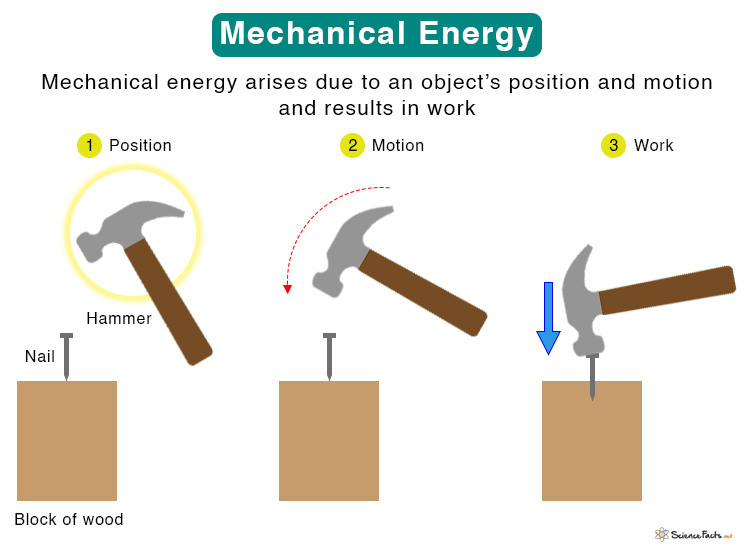An object possessing mechanical energy can do work by applying force. The change in mechanical energy is the work done. For example, when a bow is pulled, it stores energy. When released, the bow uses its stored energy and pushes the arrow to its trajectory. Thus, the bow works on the arrow at the expense of its mechanical energy. A bowling ball rolls on the alley and has mechanical energy. It does work by applying force and knocking down the pins.
Types of Mechanical Energy
Conservation of Mechanical Energy
Examples of Mechanical Energy
Mechanical Energy Equations
Conversion of Mechanical Energy
- Potential Energy: It is the energy stored in an object due to its position. Gravitational potential energy due to Earth’s gravity is a common type of potential energy. It depends on the object’s height from the Earth’s surface. For example, an apple in an apple tree has the maximum potential energy. When it falls, its potential energy reduces and becomes zero upon reaching the surface. Apart from gravitational potential energy, other forms are elastic potential energy, electric potential energy, magnetic potential energy, and nuclear potential energy.
- Kinetic Energy: It is the energy possessed by an object due to its motion. The movement of an object is manifested by its speed. Consider the above example. When the apple is in the tree, it is at rest with zero kinetic energy. When it falls, it gains speed owing to acceleration due to gravity. The kinetic energy increases and reaches a maximum when the apple hits the ground. The types of kinetic energy are electrical energy, thermal energy, radiant energy, and sound energy. Mechanical energy is conserved only when the force acting on an object is conservative. A conservative force does not depend on the path taken to do work. On the other hand, non-conservative and dissipative forces depend on the path taken. In the apple example, gravitational potential energy acts on it, which is a conservative force. If non-conservative forces like friction or air resistance are present, the mechanical energy will get converted into heat energy. In this way, although the mechanical energy is not conserved, the total energy is conserved.
- Potential Energy Suppose an object of mass m is at a height h above the surface of the Earth. Then, the potential energy can be found by the following equation. P.E. = mgh Where, P.E. : Potential energy of the object m : Mass of the object g : The acceleration due to gravity h : Height of the object
- Kinetic Energy Suppose the same object is moving with a velocity v. Then, the kinetic energy can be determined by the following equation. K.E. = ½mv2 Where, K.E. : Kinetic energy of the object m : Mass of the object v : Velocity of the object Then, the formula for the total mechanical energy of the object is Mechanical Energy = Potential Energy + Kinetic Energy Or, M.E. = mgh + ½mv2 SI unit: J or Joule (1 J = 1 kg m2/s2) Cgs unit: erg (107 erg = 1 J) Dimension: [ML2T-2]
An electric motor converts electrical energy into mechanical energy (for example, a table fan).A generator converts mechanical energy into electrical energy (for example, a dynamo).A hydroelectric power station converts the mechanical energy of water stored in a dam into electrical energy, a phenomenon known as hydroelectricity.Gasoline burns to release chemical energy, which converts into mechanical energy to drive a car.Steam energy converts thermal (heat) energy into mechanical energy.A wind turbine converts the kinetic energy of wind into electrical energy.

